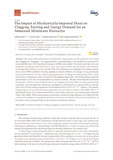JavaScript is disabled for your browser. Some features of this site may not work without it.
| dc.contributor.author | Judd, Simon J. | |
| dc.contributor.author | Odai, Albert | |
| dc.contributor.author | Buzatu, Pompilia | |
| dc.contributor.author | Qiblawey, Hazim | |
| dc.date.accessioned | 2018-12-14T09:59:25Z | |
| dc.date.available | 2018-12-14T09:59:25Z | |
| dc.date.issued | 2018-11-10 | |
| dc.identifier.citation | Simon Judd, Albert Odai, Pompilia Buzatu and Hazim Qiblawey. (2018) The impact of mechanically-imposed shear on clogging, fouling and energy demand for an immersed membrane bioreactor. Membranes, 2018, Volume 8, Issue 4, Article number 104 | en_UK |
| dc.identifier.issn | 2077-0375 | |
| dc.identifier.uri | https://doi.org/10.3390/membranes8040104 | |
| dc.identifier.uri | http://dspace.lib.cranfield.ac.uk/handle/1826/13733 | |
| dc.description.abstract | The impact of the application of mechanically-imposed shear on the propensity for fouling and clogging (or “sludging”—the agglomeration of sludge solids in the membrane channel) of an immersed flat sheet (iFS) membrane bioreactor (MBR) was studied. The bench-scale test cell used contained a single flat sheet fitted with a crank and motor to allow the membrane to be oscillated (or reciprocated) vertically at a low rate (20 RPM). The membrane was challenged with sludge samples from a local MBR installation treating petroleum industry effluent, the sludge having previously been demonstrated as having a high sludging propensity. Sludging was measured by direct visual observation of membrane surface occlusion by the agglomerated solids, with fouling being notionally represented by the rate of transmembrane pressure increase. Results demonstrated membrane reciprocation to have a more beneficial impact on sludging amelioration than on suppressing fouling. Compared with the stationary membrane, sludging was reduced by an average of 45% compared with only 13% for fouling suppression at the reference flux of 15 L·m−2·h−1 applied. The specific energy demand of the mechanical shear application was calculated as being around 0.0081 kWh·m−3, significantly lower than values reported from a recent pilot scale study on a reciprocated immersed hollow fibre MBR. Whilst results appear promising in terms of energy efficiency, it is likely that the mechanical complexity of applying membrane movement would limit the practical application to low flows, and a correspondingly small number of membrane modules. | en_UK |
| dc.language.iso | en | en_UK |
| dc.publisher | MDPI | en_UK |
| dc.rights | Attribution 4.0 International | * |
| dc.rights.uri | http://creativecommons.org/licenses/by/4.0/ | * |
| dc.subject | membrane bioreactor | en_UK |
| dc.subject | fouling | en_UK |
| dc.subject | clogging | en_UK |
| dc.subject | mechanical shear | en_UK |
| dc.subject | specific energy demand | en_UK |
| dc.title | The impact of mechanically-imposed shear on clogging, fouling and energy demand for an immersed membrane bioreactor | en_UK |
| dc.type | Article | en_UK |
Files in this item
The following license files are associated with this item:
This item appears in the following Collection(s)
-
Staff publications (SWEE) [2827]

